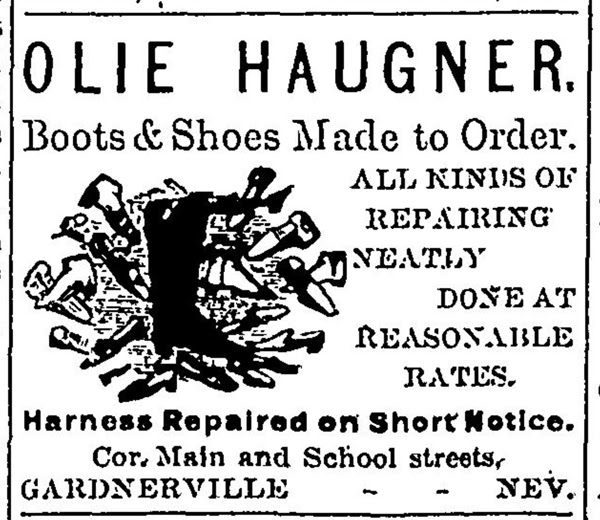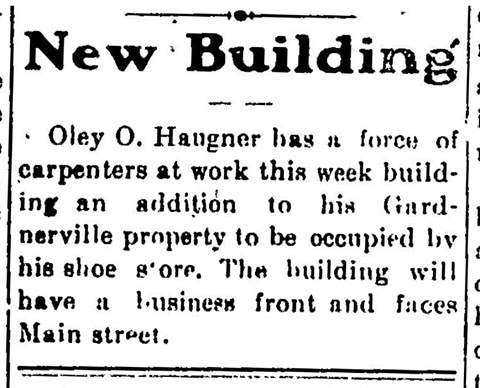We left off last time (in Part 1) with Frank Yparraguirre moving his Perry’s Dry Goods store into Gardnerville’s Coolest Building, after shoemaker Ole Haugner passed away in 1940.
But what was Ole Haugner’s story? Well, he was born in Ingerberg, Norway October 12, 1855, emigrating to the States in 1880. He settled initially up at the Lake, making boots and shoes for the loggers and lumbermen at the mills. But as the Comstock mines began to fade and the timber trade fell off, Haugner began casting an eye around for greener cobbling pastures.
He found them, in the growing town of Gardnerville.

A newspaper blurb in October, 1897 reported that Haugner had rented a house in Gardnerville, identifying his trade as “harness-maker.” But by early that December, Haugner was announcing he’d opened a shoe shop.
Haugner apparently did well in the new town of Gardnerville. By the following April, (1898), Haugner was purchasing the house and lot he’d been renting. He moved his family down from the Lake that fall. (His former house at the Lake didn’t go to waste, either; it was moved to Gardnerville in August, 1899 where it became part of Jaynes’ livery stable across from the Ritchford.).

And now comes a bit of a mystery. The property on Main Street that Haugner bought in 1898 already had a house on it when Ole purchased it. Was that the old Gardner ranch house that reportedly sits there today? Or did Haugner himself move the Gardner house to his property, as some later accounts suggest? We don’t know the answer for sure.
It’s also not clear where Haugner’s shoe shop was located in this initial period of time, either. Haugner’s advertisements about this time vaguely proclaim his location as the “corner of Main and School” (today’s Gilman Avenue).

We suspect that his shoe business in these early days was separate from his home. One tantalizing photo confirms that Haugner had hung out his shingle (a boot, naturally) on Henry Beste’s house sometime around 1900 (today, the site of Napa Auto Parts). High School Street hadn’t yet been cut through, but this location would put it not far from Gilman aka the early School Street, just as his ad proclaimed.

As for the early Haugner residence, homestead records give dimensions of the old Gardner ranch house as about 15 x 20 feet in size. That would have made living quarters tight indeed for Haugner, his wife, and their soon-to-be five children. It’s possible that a short addition was tacked onto this small house along the way, using lumber from Haugner’s contacts in Tahoe.
And finally, in 1910, Haugner had a tall, two-story portion added to the front of his home to serve as his very own shoe shop.


So that helps explain the strange, narrow shape of the building today! If you’ll pardon the bad pun, this tall front section was “shoe-horned” onto the lot, attaching to the old Gardner house that already stood in the rear.
And now here’s a second fun “secret” about this cool old building: Tom Fowler, the builder of the two-story structure, reportedly left his signature and the date of his addition inscribed on the rafters up in the attic.

Ole Haugner wasn’t the only one selling shoes in early Gardnerville, of course. A competitor, John Henry Rosenbrock, ran the Douglas County Shoe store in a tidy brick building just across the street, at 1443 Main. But despite the competition, Haugner prospered. He was known as an “expert” at his trade. A laudatory article described Haugner as a “shoemaker of the old school.”
After more than four decades in business, Ole Haugner finally passed away in 1940, at the ripe old age of 85. And that’s where Frank Yparraguirre entered the picture (as we saw in Part 1). Frank went on to run Perry’s Dry Goods at this spot for almost another 50 years, finally passing away in August, 1989. (Like his predecessor, Frank, too, made it to age 85!)
During his own tenure, Yparraguirre made extensive repairs and alterations to the buildings. By then, he would say, the old Gardner ranch house in the rear was sitting on just worm-eaten pine stumps. And the two-story front, with rocks and wooden blocks as a foundation, was so unsteady Yparraguirre once recalled the building would rock whenever a west wind blew. He added a concrete foundation for stability under both buildings. He also “studded the walls out” inside the old Gardner house, preserving the original ceiling and floors. The old 1 x 12-inch boards that once had formed the old building’s exterior walls were salvaged and installed diagonally as “sheeting” (sheering).
Today, the Haugner/Perry’s building is a proud home to “Battle Born Wine.” And as the plaque on the front proclaims, the rear section — believed to be the former Gardner Ranch home — is likely the oldest building in town.

